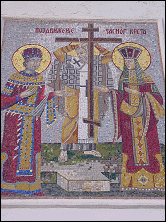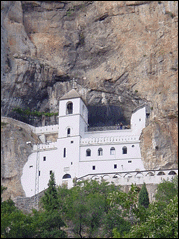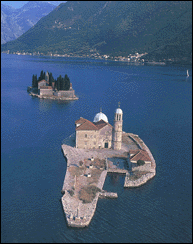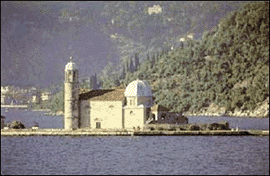 CHURCH AND RELIGION CHURCH AND RELIGION |
 I. Christianity in Montenegro - From the 4th to the 14th Century I. Christianity in Montenegro - From the 4th to the 14th Century |
Christianity started in Montenegro in the fourth century. The population then consisted of Romans and Romanized Ilirs. The monasteries here, just like in other parts of the world were the centres of literature and other cultural activities.
In the 12th century, the neighboring Raska (the ancient name of Serbia) occupied Duklja (the ancient name of Montenegro), destroying many Catholic churches and Monasteries. Raska formed three Eastern Orthodox episcopacies in Duklja, and the Catholic church was only preserved to maintain at least some form of relations with the west.
In the middle of the 14th century Duklja started to free itself from the Raska domination, and, under the name of Zeta, soon became a Catholic country again. This changed after Turkey became a predominant force in the area with its promotion of Islam and Eastern Orthodoxy at the expense of Catholicism.
 II. The Orthodox Church - 15th Century II. The Orthodox Church - 15th Century |
When the capital of Montenegro was moved from the area near the Lake Scutari to Cetinje, the Orthodox Church got a new center too - the Cetinje Monastery, built in 1484.
For many centuries, the theocratic government and its Autocephalic Orthodox Church played an important role in the history and culture of the Montenegrin people. The Metropolitans (vladikas), chosen traditionally by the public, were heads of the church and of the state. The Metropolitans carried weapons and took part in the wars, often as commanders or leaders.
The Montenegrin Orthodox Church has four saints: Saint Steven Piperski, Saint Vasilije Ostroski, Saint Petar Cetinjski , Saint Vladimir of Duklja

- Saint Vasilije Ostroski: "Health protector" after his demise his remains continued to act curatively -
Saint Vladimir, was the founder and king of the independent state of Duklja (Montenegro) and ruled it until it was captured and occupied by Serbian despot Steven Nemanja in 1186.
It was after this time that the Montenegrins were forced to change their religion from Catholicism to the Orthodox religion, the religion of Raska (Serbia). Their acceptance of this new religion is often misinterpreted to mean that Montenegrins are Serbs.
After the collapse of the Serbian state in the 15th century, Montenegro, under the name of Zeta, resisted the Turkish penetration into the Balkan Peninsula. Meanwhile the Serbian church fell under Turkish dominance and for five hundred years was controlled by the patriarchy of Constantinople. The Montenegrin church remained independent, recognized by the Holy Synod of the Russian Orthodox Church as well as by the Ecumenical Patriarchal (the Eastern Pope of Constantinople).
In 1904 during the reign of king Nikola I (1841-1921), the Montenegrin Orthodox Church was granted its Charter of the Holy Synod of the Principality of Montenegro (Ustav Svetog Sinoda).
The Montenegrin Autocephalic Orthodox Church functioned independently until 1920. With the destruction of the Kingdom of Montenegro, the Church suffered the same fate. Following the unification of Montenegro and Serbia (1918), the Montenegrin Orthodox Church was abolished uncanonically by King Alexander Karadjordjevic. The king issued a decree according to which all the Montenegrin monasteries became possession of the Serbian Orthodox Church.
 III. Montenegro & Religions in the 21st Century III. Montenegro & Religions in the 21st Century |
In today's Montenegro there are three main religious faiths: Eastern Orthodox, Catholic and Muslim. Although Eastern Orthodox Christian is the predominant religion, Montenegrins of all faiths have always lived together and continue to coexist in a multi-religious society based on human values. Montenegro's existence at the boundary between West and East has resulted in a highly complex cultural and religious mixture. Some churches even have two altars, one Catholic and one Orthodox.
Following the centuries-old tradition of popular election of the Montenegrin Metropolitans, in 1993 in Cetinje, the ancient capital of Montenegro, the people of Montenegro elected their own Metropolitan, "His Holiness Antonije Abramovic" who was the spiritual leader of the renewed Montenegrin Autocephalic Orthodox Church until his death in 1996. The new Vladika is Miras Dedeic, who was recently promoted to archimandrite under the monastic name Mihailo.
The Orthodox Christian faith has a powerful element of togetherness. There are many churches, but they are usually small and the priests have always lived the life of their believers, that is to say they also participated in the armed struggle against the conquerors.
Faith was and is an important component of the life, it is an essential part of everyday customs. It comes more from the respect of the virtues and protection from sin and it is also part of the customs. Loyalty to their faith is one of the basics of the survival of the nation. They were fighting for their freedom with the cross "in their hands". With the help of a strong faith they sought for the mercy of God in helping them to achieve their aims.
Despite temporary, but sometimes heavy conflicts between people of different religions, there is a peaceful coexistence of various religions. Today, all the different religions with their churches and mosques are actually all making up the cultural richness of the society.
Another important part of life and religion is the close ties that they maintain with their families during a lifetime. The family is always there to help, even today. To attend the big family events are a must for all its members.
Special emphasis is given to the day when the family celebrates the day of its Saint. Usually, it is a church saint, that has been chosen by the family as their protector. In honor of this saint, the whole family gets together, the most beautiful table is taken to eat at, the members of the family wear their nicest clothes in order to show their respect and of course the women of the family cook and lay the table the most beautiful way possible. Apart from the members of the family, the closest friends are also always invited. Nowadays, the whole get together has more human warmth, than ritual.
 Monastery of Ostrog Monastery of Ostrog |
Monastery of Ostrog is situated high above the Bjelopavlicka valley in the northwest, by a steep rock between the towns of Niksic and Danilovgrad.
Although the initial basis for this monastery was made by the ascetics who found a fitting place in the rocks of Ostrog it is Saint Vasilije of Ostrog, the Metropolitan of Zahumlje and Herzegovina, that is rightly held to be its original founder.
When assigned with jurisdiction of the eastern Herzegovinian eparchy in the second of half of the 17th century, St.Vasilije settled to dwell in Onogost, the present-day Niksic. Because of his ascetic urges, he could not be content with the living at his new, cosy residence. He craved a hermitage and isolation. He was even thinking about going to Holy Mount Athos which attracted him most but as the Bjelopavlici tribe learning of this, they implored him not to leave the country.
The Saint gave in to the people's affection and turned to seek an adequate place for him to lead an ascetic life. While dwelling in the nearby village Popi, he heard about the previous ascetics who had chosen to live as anchorites. Himself originally from Popi near Niksic, Isaija had done his ascetic accomplishments in the cave which today houses the upper church of the Monastery of Ostrog, dedicated to the Holy Cross. On finding this cave, St. Vasilije fasted and offered prayers in it himself.
But he could not be separated from the people and its religious and moral life, too. According to archimandrite Nikodim Raicevic, St.Vasilije directed the eparchy from Ostrog for 15 years. As he is known to have died in 1671, he appears to have left Niksic for Ostrog in about the year 1656.
Thoroughly filled with the spirit and tradition of the Orthodox monasticism, St.Vasilije felt an urge to serve and be useful not only to himself but to others, the entire people. Therefore, he made efforts towards turning his cave into an Orthodox monastery, which is ever a spring only of the religious but also whole spiritual life for local people. So he started to gather a brotherhood by his name of hiermonk Isaiah "the grandson of our holy and venerable Father Isaija from Onogost, from the village Popi." .
| The fresco-painting sadded two years later. Below this tiny church, St.Vasilije put to use the church of the Presentation of the Holy Virgin, whose date of settlement cannot be established correctly. The tradition has it that it was erected by the ascetics who lived there before St.Vasilije, while the Serb scholar Vuk Karadzic put it down by what he heard from then Ostrog archimandrite Nikodim Raicevic that this church was built by St.Vasilije himself. Its interior was probably fresco-painted in 1667. This church holds the relic of St.Vasilije's holy body.
His ascetic achievement hardly drew St.Vasilije apart from his duties of tending his flock and being an archpriest. Quite the contrary, his ascetic life only developed the people's respect for him even more. He was actually understood by his contemporaries as "an angel on earth and man of heaven," a chosen receptacle for Holy Spirit through which the Heaven acted on the earth.
During his stay at Ostrog and construction of the monastery, St.Vasilije spent his own income to purchase the land which would be the material basis for the monastery and brotherhood to maintain themselves by.
 St. Vasilje St. Vasilje |
St.Vasilije (Basil) of Ostrog was born in Popovo Polje in Herzegovina, but the exact date is unknown. The Ostrog monks used to speak of a handwritten book they kept at the monastery which included a hagiography of St.Vasilije. The volume disappeared at the time of the raid on Montenegro by the Ottoman Turks in 1852-3. The hagiography allegedly said that St.Vasilije was born on 28 December, 1610 and that his (secular) Christian name was Stojan. Vuk Vrcevic put it down by the people's oral record that St.Vasilije was forty years old when he left Tvrdos for Ostrog. As this is known to have taken place in 1651, the lost hagiography appears to have been fully correct. Additionally, there is strong evidence that the Saint was named Bishop as a very young man, as he was Metropolitan of Zahumlje as early as 1639.
Very early he became Metropolitan of the western parts of Herzegovina and as soon as 1639 he signed himself in the Chronicle by Jovan Zonara as "humble Metropolitan of Zahumlje Vasilije."
In 1671, it was written: "Vasilije, the Bishop of Zahumlje and Skenderija, has gone to God, to rest in his holiness." "And when he passed away," archimandrite Nikodim Raicevic recounted it to (Serb scholar) Vuk Karadzic, "his body was interred below the monastery, in the orchard ground. Seven years after his death, the Zupa monastery abbot, who was then at Ostrog, saw in his dream one night late Bishop Vasilije, asking to be unearthed. He dreamed the same dream once more…Bishop Vasilije appeared in his dream for the third time…As he told his dreams to other brothers at Ostrog…they took hoes, picks and shovels…and unearthed it. In it was Bishop Vasilije, his body whole, untouched and holy. Then they placed him into the holy casket at the church of the upper monastery, where it has been ever since and is today."
 The Miracles The Miracles |

- Monastory of Ostrog -
Saint Vasilije of Ostrog is a grand worker. His sacred body which is entire still today is resting at the Ostrog Isposnica (the House of Ascetism), defying the law of decomposition. The fact that this great Saint's body is quite untouched by rot is a phenomenon in its own right that we Christians call a miracle.A miracle even greater than this is the miraculous power of his body as a relic. Not only the Orthodox, but also the Roman Catholics and Muslims know of the cases of amazing healing at Ostrog. These have been testified to by those who by their own eyes witnessed and personally experienced these miracles of God.
On several occasions, the sacred body of St.Vasilije has been carried from the monastery and hidden away from the raids by the Turkish army. First it happened in 1714. Another time, during the siege of Ostrog in 1852, the casket with the relic was transferred to Cetinje. Last, it was taken to Cetinje in 1877, where it stayed for a year and was returned to Ostrog in 1878. There is little knowledge about the holy casket in which the sacred body rests. Namely, it is unknown how many and what kind of holy caskets could have been used to hold the relic before the present-day one, from 1852.
 Church Our Lady of Skrpjeli Church Our Lady of Skrpjeli |
The church of Our Lady of Skrpjeli, patroness of seamen and fishermen, was built in 1630 on an artificially formed islet, in front of Perast in Boka Kotorska Bay, on the place of an older construction.

- Church Our Lady of Skrpjeli -
According to folk tradition, Perastan fishermen found on the cliff an icon of mother of God with Christ, which served as a motif for construction of temple. The temple was built appendages several times. So, between 1720 and 1725 an octagonal presbytery with dome and round bell-tower were built appendages. The interior of church is adorned by a marble shrine, built by Antonio Capelano, sculptor from Genoa, in 1796. On the shrine there is the icon of mother of God with Christ, renowned icon of Our Lady of Skrpjeli, painted by famous painter Lovro Dobricevic by the middle of the 15th century.
The walls and the ceiling are covered with paintings on canvas by Tripo Kokolja, one of the most famous baroque painters in our country. Sixty eight paintings, some of them of extraordinary large size, make the church Our Lady of Skrpjeli to be experienced as a specific gallery of baroque painting emerged on the expanses of South Adriatic.
Sixty eight paintings, some of them of extraordinary large size, make the church Our Lady of Skrpjeli to be experienced as a specific gallery of baroque painting emerged on the expanses of South Adriatic.
Sixty eight paintings, some of them of extraordinary large size, make the church Our Lady of Skrpjeli to be experienced as a specific gallery of baroque painting emerged on the expanses of South Adriatic.
Among the paintings, on side walls, there are numerous votive silver tablets, with relief images of Boka's ships protected by Our Lady of Skrpjeli in marine tempests. Various exhibits collected in the area of Perast and closer surrounding are exhibited in church museum.

One of especially interesting exhibits kept in Billiard House (Biljarda) is a famous Njegos's billiard after which Njegos's residence was named. Billiard was brought from Vienna in 1839. It was situated in the largest room of Billiard House. In addition to billiard, the room is adorned by a collection of Njegos's personal weapons and the portrait of Njegos in folk costume, work by Vienna's painter Johan Bes from 1847.
A part of preserved Njegos's library consisting of more than 550 titles written in 9 classic and living languages, what witnesses that Njegos belonged to a plied of best educated people of his time. The original manuscript of Mountainous Wreath (Gorski vijenac) is exhibited in this study, as well as a manuscript of one of the most beautiful love poems. |

